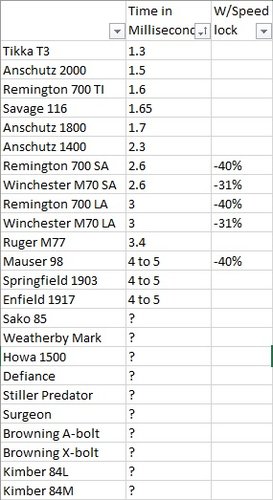MinnesotaHunter
Well-known member
Last summer, on the recommendation of BuzzH, I installed a Tubbs Speedlock firing pin assembly on my custom .260 Rem. At the time I basically understood the concept, but recently wanted to learn a bit more.
So.....I have been on paternity leave for the last couple of weeks, and while my new little one and wife have been napping, I have had some time to read about some shooting/hunting stuff. One of the things I have been looking at (thinking about) is the affect of lock time on field shooting accuracy.
The basic concept is this: "a reduction in lock time will cause your rifle to hit closer to where you held the sight when you pulled the trigger. Everyone's rifle is moving when it's fired. The amount of movement may be almost imperceptible, but that's all it takes. If you're shooting at a trophy deer at 300 yards, movement at the muzzle of only 0.058 inches means a missed animal. If you're a competitive silhouette shooter, just 0.022 movement makes the difference between a hit and a miss on a 500 meter ram. When lock time is reduced, the probability of hitting your target is increased." (from David Tubb, maker of Speedlocks)
My thought is that this idea is even more important in a hunting rifle when shooting from less stable field positions. The calculations on my 260 are that with my new assembly the bullet is about 25ft out the barrel, before the old assembly would have ignited the primer. Seems like a pretty nice advantage to me. I cannot say at this point that I have noticed a dramatic shift in accuracy, but anecdotally, when I have shot from field positions (sitting w/bipod in particular) things seem to have tightened up.
That all being said, I started to wonder how my other rifles compared to my 260, so I started searching the internet for mentions of other rifle models factory lock times. I found some, but a lot were no where to be found. I thought I would post up what I found and see what some of you guys who are surely smarter than me when it comes to this type of stuff, might be able to fill in the blanks. From what I have found, there is certainly some inconsistency in how this is measured, so don't shoot the messenger. Of particular note, given the recent discussion of the Tikka T3s, I found several sources stating that it has the fastest lock time of any factory rifle today.
While it certainly isn't the silver bullet to instant field shooting prowess, at half the price of a Timney trigger, guys ought to be looking at them.

So.....I have been on paternity leave for the last couple of weeks, and while my new little one and wife have been napping, I have had some time to read about some shooting/hunting stuff. One of the things I have been looking at (thinking about) is the affect of lock time on field shooting accuracy.
The basic concept is this: "a reduction in lock time will cause your rifle to hit closer to where you held the sight when you pulled the trigger. Everyone's rifle is moving when it's fired. The amount of movement may be almost imperceptible, but that's all it takes. If you're shooting at a trophy deer at 300 yards, movement at the muzzle of only 0.058 inches means a missed animal. If you're a competitive silhouette shooter, just 0.022 movement makes the difference between a hit and a miss on a 500 meter ram. When lock time is reduced, the probability of hitting your target is increased." (from David Tubb, maker of Speedlocks)
My thought is that this idea is even more important in a hunting rifle when shooting from less stable field positions. The calculations on my 260 are that with my new assembly the bullet is about 25ft out the barrel, before the old assembly would have ignited the primer. Seems like a pretty nice advantage to me. I cannot say at this point that I have noticed a dramatic shift in accuracy, but anecdotally, when I have shot from field positions (sitting w/bipod in particular) things seem to have tightened up.
That all being said, I started to wonder how my other rifles compared to my 260, so I started searching the internet for mentions of other rifle models factory lock times. I found some, but a lot were no where to be found. I thought I would post up what I found and see what some of you guys who are surely smarter than me when it comes to this type of stuff, might be able to fill in the blanks. From what I have found, there is certainly some inconsistency in how this is measured, so don't shoot the messenger. Of particular note, given the recent discussion of the Tikka T3s, I found several sources stating that it has the fastest lock time of any factory rifle today.
While it certainly isn't the silver bullet to instant field shooting prowess, at half the price of a Timney trigger, guys ought to be looking at them.





